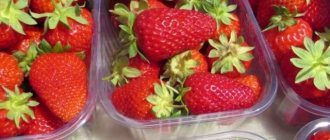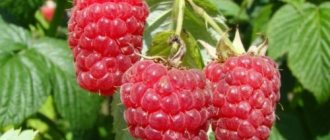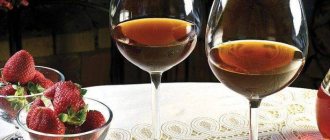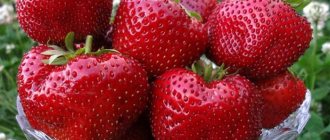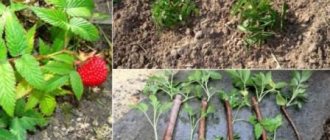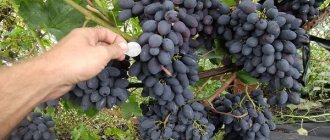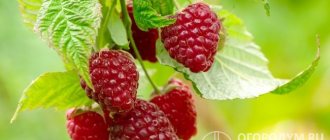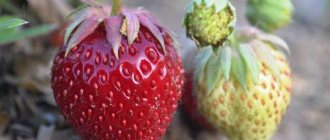Zenga Zengana is an undeservedly forgotten garden strawberry of European selection. Once it was the best industrial variety, but today, thanks to its unique qualities, it has become interesting to amateur gardeners. Let's find out what's unusual about this strawberry and how to grow it in our area.
garden strawberries "Zenga Zengana" ripen in mid-June
Fruiting of the "Zenga Zengana" variety lasts until early September
berries of garden strawberries "Zenga Zengana" weigh 10-15 grams, but there are specimens weighing 30 grams
Briefly about the origin
Garden strawberries (also known as strawberries) of the Zenga Zengana variety were bred in Germany (Hamburg). The variety arose by crossing the Sieger variety and the wild self-seeder Merge. Breeders have set a goal - to develop strawberries for industrial use. Selection work began in 1942 and ended in 1954.
This well-deserved variety, although it has lost its popularity over 70 years, remains a real brand. Having quickly spread throughout Europe, Zenga Zengana has long been the leading industrial variety.
History of the Zenga Zengana variety
The history of the variety began in Germany in 1942, when the issue of deep freezing of vegetables and fruits was relevant. The Marche strawberry was used as a basis, with very dense berries that do not lose their shape after defrosting, but with low taste. After repeated crossings of Marche with varieties that had good taste, in difficult war conditions in the summer of 1945 in Luckenwald, several successful plant variants were obtained.
However, with the end of the war, the direction of breeding work changed, now the first place was given to yield, good taste, resistance to diseases and pests, and the ability to grow under different climatic conditions. The parents of the most successful three clones that survived the mite invasion in 1949 were the Markee and Sieger varieties. Isolating and propagating the most productive seedlings, in 1954 breeders introduced a variety called Zenga Zengana.
The difference between the variety and other strawberries
The Zenga Zengana variety has always been unique. At the beginning of its “career” one of its main advantages was the ability to freeze. Today, many varieties of strawberries have this quality. But its other quality still remains unique - according to reviews from gardeners, Zenga Zengana does not lose varietal qualities for 7-8 years.
Among the positive qualities of the variety are also:
- consistently high productivity;
- excellent taste;
- good transportability;
- undemanding to soils.
One of the most important advantages of the old German variety is its ability to grow in any soil. Zenga Zengana bears fruit even on heavy, loamy and depleted soils.
The disadvantage of the German variety can be considered the need for pollinators.
Origin and official registration
"Zenga Zengana" was obtained by German breeders (the author is considered to be Professor Reinhold von Sengbusch) near Hamburg as a seedling from the parent varieties "Marke" and "Sieger". Zenga became the first strawberry suitable for deep freezing, received a license and went on sale back in 1952.
Many domestic and foreign agricultural companies and nurseries are engaged in the production and sale of planting material.
In the former Union, the variety has been under state variety testing since 1969, in 1972 it was officially registered in the State Register of the Russian Federation, and in 1975 in the register of Belarus. "Zenga" is perfectly adapted to various climatic conditions and is zoned for cultivation in the North-Western, Central, Volga-Vyatka, Central Black Earth, North Caucasus, Middle and Lower Volga, Ural regions of Russia and throughout Belarus. It has also taken root well in the vastness of Ukraine.
Everything about the variety: description, characteristics, taste
The Zenga Zengana variety is capable of bearing fruit in short daylight hours. If the duration of the latter is 12 hours, bud formation occurs.
Main characteristics of the variety:
- Ripening dates are late. The first berries appear in mid-June.
- Productivity – 1.5 kg per bush.
- The bushes bear fruit in one place for 6-7 years.
- Non-repairing variety - bears fruit once per season.
- A small number of whiskers means the plant spends all its energy on producing fruits.
- The weight of the berries is 10-12 g. The first berries are the largest - up to 30 g. As they bear fruit, they become smaller.
- The dense, void-free pulp has a sweet and sour taste and rich aroma.
- The purpose is universal. Berries do not lose their shape in compotes and jam. Suitable for freezing.
- The variety can withstand heat, drought and low temperatures.
Brief botanical description:
- Bush. Tall, not spreading, but well leafy. Peduncles are located at the same level with the leaves or under them - the berries can touch the ground. The leaves are dark green, smooth.
- Berries. Medium size. The shape is wide-conical. The color depends on the amount of sun - in the shade the berries are bright red, in the sun they are dark red. Ripe berries become dark cherry. The seeds are deeply pressed.
Watch a video review of garden strawberries "Zenga Zengana", presented by an experienced gardener:
Growing conditions
To obtain a stable strawberry harvest, it is important to choose a suitable growing area, properly lay out the bed and provide minimal care conditions. Senga Sengana responds well to watering and fertilizers and is not too demanding to care for.
Landing
For growing, it is important to purchase high-quality planting material. Before rooting, it is treated with antiviral and immunostimulating drugs.
Landing site requirements:
- good lighting;
- remoteness of tall trees and groundwater;
- breathable, light, fertile soil of neutral acidity.
Strawberries are planted in a single-line or double-line manner at a distance of 30 cm from each other. The depth of the hole should not exceed 20 - 25 cm. Roots that are too long should be trimmed.
Care
During the summer, it is necessary to remove weeds and water as the soil dries out. Summer residents solve the problem of weeds by planting bushes on black agrofibre and retaining moisture using mulch. These simple measures make the care process easier.
Advice. It is advisable to plant several bushes of another late-ripening variety next to German strawberries to increase the number of ovaries. Garlic is also considered a good plant neighbor; it repels pests and preserves the harvest.
Reproduction
Strawberry bushes form a small number of tendrils. For propagation, daughter rosettes are rooted in separate glasses or directly on the garden bed.
Fertilizer
Many summer residents consider an infusion of bird droppings and ash to be the most effective for feeding plants. The first time fertilizing is carried out in the spring after removing the covering layer. The next application of fertilizer is done when the first strawberry leaves appear. Before flowering, phosphorus fertilizers are applied. The last time before wintering, the soil is fertilized with a potassium-nitrogen mixture.
Boarding order
This German variety, although unpretentious, requires some care. And it starts with the correct landing. Although Zenga grows in any soil, the gardener’s task is to create favorable growing conditions in order to get maximum benefit.
Choosing a place and timing
In temperate climates, seedlings are planted mainly in early spring, late summer or early autumn. The best time for planting is the first ten days of spring. In the central regions, seedlings are planted on March 10-20. It is best to plant seedlings in the evening of a dry, sunny day. Read more about planting strawberries in spring here.
Before preparing the seedlings, choose a suitable place for planting. Optimal site characteristics:
- Sunny, well-ventilated place, without stagnant water. It is advisable that the site be located on the south side, but not blown by the winds. Lowlands and highly acidic soils are not suitable.
- Strawberries grow best after legumes, radishes, carrots, beets, onions and garlic. Undesirable predecessors prone to diseases that affect Zenga Zengana - black currants, raspberries, gooseberries.
Soil preparation
Despite its undemanding requirements for soil, the variety has its own preferences - it grows best on loam with a neutral reaction.
Soil preparation procedure:
- Clear the area of weeds. If there are chafer larvae, wireworms and other pests in the soil, treat it with an ammonia solution - dilute 10 ml in a bucket of water.
- Dig up the soil 2-4 weeks before planting. During digging, fertilizers are applied per 1 sq. m:
- humus – 5-6 kg;
- superphosphate – 40 g;
- potash fertilizers – 20 g.
- Check soil acidity. And if it is increased, add dolomite flour - 300-600 g per 1 square meter. m. Instead of flour, you can add chalk or ash, respectively 100-300 g and 1-1.5 kg per 1 sq. m. m.
You can determine the acidity yourself by looking at beet leaves - on acidic soils they become covered with dark red spots.
Wood ash can be used as potassium fertilizers, but potassium chloride is not recommended - strawberries are too sensitive to chlorine.
Planting schemes
Seedlings of the Zenga Zengana variety are planted according to typical strawberry patterns:
- One-line. The interval between rows is 70 cm. Between adjacent bushes in rows is 20 cm.
- Two-line. Several rows are planted in one bed. Leave 70 cm between the beds, 30 cm between the lines, and 20 cm between the bushes.
When growing strawberries, the growing method using covering material is very popular. The planting pattern is the same - horizontal, but the soil is covered with a black film. And so that the roots do not overheat under the film, it is covered with a layer of straw.
Transplanting
Optimal temperature conditions for planting seedlings in open ground:
- air – from +15 to +20 °C;
- soil – about +15 °C.
Healthy, well-developed seedlings are selected for planting. They leave about 5-7 leaves, the rest are torn off. The optimal length of the roots is 8-10 cm, longer ones are cut off. Before planting, the roots of the seedlings are placed in a growth stimulator.
Boarding order:
- Holes are dug in the prepared beds according to the number of seedlings. Depth - about 15 cm. A small earthen mound is formed in each hole.
- Lower the seedling into the hole, carefully straightening the roots.
- Cover the roots with soil, compacting the soil with your hands. The growth point of the seedling should be at ground level. If the point is buried, the bushes will begin to rot.
- Water each hole with warm water - about 1 liter per bush.
- It is advisable to mulch the soil with humus, straw or sawdust. Do not mulch the soil with leaves, moss or freshly cut grass. The mulch layer is about 10 cm.
Features of care
Caring for Zenga Zengana strawberries is not particularly difficult. It is only important to follow all care instructions on time.
Watering
The variety is moisture-loving, so the plantations are watered regularly - every 1-2 weeks. Weather conditions and amount of precipitation are taken into account. In hot weather, the frequency of watering increases.
When watering, the soil should be moistened 20-30 cm deep. Water is poured so that drops do not fall on the leaves. The best time for watering is morning. The most important watering is before flowering, then they are carried out as necessary.
Top dressing
Strawberries are fertilized with organic and mineral fertilizers. They begin to feed the plantings in early spring. When feeding, it is important not to overdo it with nitrogen fertilizers. They are applied in the spring because they stimulate the growth of green mass. An excess of nitrogen will have a bad effect on yields.
We recommend that you additionally read the article about spring fertilizing of strawberries.
Timing and types of fertilizing of Zenga Zengana strawberries:
| Period | Fertilizers applied |
| Early spring | Nitrogen fertilizers - for example, urea, for the growth of green mass. To prepare the solution, take 30 g per 10 liters of water. |
| The appearance of the first leaves | Watering with mullein with the addition of ammonium sulfate. |
| Beginning of May | Application of complex mineral fertilizers. |
| Before flowering | Potassium-based solutions - from potassium nitrate, potassium sulfate (per 10 l - 2 tbsp). You can water the plantings with a solution of ash. |
| After harvest | Phosphorus fertilizers - ammophos, superphosphate, diammophos - increase the yield of berry fields for the next year. |
Potassium fertilizers improve the taste of berries.
Loosening, weeding and mulching
The soil is loosened before each watering, and after watering it is mulched. Usually the soil is sprinkled with sawdust - a layer of 5 cm. During loosening, weeds are simultaneously removed.
The most intensive loosening is in spring, when there is a lot of melt water in the soil. Loosen the row spacing to a depth of 10 cm. Closer to the bushes, the loosening depth is less so as not to damage the root system. During loosening, the bushes are hilled up a little to cover the roots.
Preparing for winter
Preparation for winter consists of several agrotechnical measures:
- The area is carefully weeded and loosened.
- The plantings are sprayed with compounds against pests and diseases.
- All tendrils and leaves are trimmed.
- Sprinkle the planting with a thick layer of mulch - sawdust or peat. Where there is a little snow, straw can be used; in regions with harsh winters, spruce branches can be used.
After wintering, the plantings must be cleaned - mulch and weeds are removed.
First-year bushes are completely covered with coniferous branches for the winter. Or they stretch agrotex/spunbond onto the frame - you can’t put them on rows, the soil will quickly freeze.
Reproduction methods
Most often, gardeners use division to propagate Zenga Zengana strawberries. But if desired, this variety can be propagated by any of the existing methods:
- Dividing the bush. The best option. They dig up a 4-year-old plant, cut off the dry foliage, immerse the roots in water, and when they soften, divide the bush into several parts - divisions.
- Mustaches and rosettes. You can’t get a lot of seedlings this way - due to the limited number of tendrils. The shoots - tendrils - appear in July, they take root, and along with rooting, a small bush appears - a rosette. Select shoots from the most productive bushes. The earth is loosened and watered, helping the development of the first two rosettes. Then the tendril is cut off so that it does not draw nutrients from the mother bush. When the shoots have developed sufficiently, they dig them up and replant them.
- Seeds. Zenga's flowers are female. And it is impossible to obtain seed material from fruits with a set of qualities of the mother plant. Unless the Zengan hybrid and its pollinators grow. The propagation process is standard: The seeds are stratified - soaked and kept in the refrigerator at +5 °C for two weeks. The seeds are moistened in time so that they do not dry out.
- The replacement is sown in a container and covered with film. When sprouts appear, the film is removed.
- Plants are planted in the ground when 3-5 leaves appear on the bushes.
Preparing for winter
When the fruiting of the berries is over, and it gets noticeably colder outside, the strawberries are cut off from the mustache and green leaves. Before covering the soil, it needs to dry thoroughly. If the soil is wet, the berry will begin to rot and its roots will rot. Straw is poured onto dry soil and leveled in an even layer. The straw is pressed down with tree branches or immediately covered with thick cellophane. Leave the strawberries under cover until spring arrives.
Attention! You can open the berries when the daytime temperature is not lower than 7-9 degrees Celsius.
Disease and pest control
The main pest threatening the old German variety is the strawberry mite. And the most dangerous disease for Zeng Zengan is gray rot.
Pests and diseases of the Zenga Zengana variety, as well as measures to combat them:
| Pests/diseases | Symptoms/harm | How to fight? |
| Strawberry mite | An insect invisible to the eye attacks the leaves - they become deformed, turn brown and dry out. The growth of the bushes slows down, the berries become small. | To prevent planting, spray it with colloidal sulfur (70% solution). If the mite has already attacked the plants, they are treated with insecticides - Iskra M or Actellik. |
| Gray rot | A fungal infection that can destroy 90% of the crop. The berries become covered with a dark coating and rot. | Remove affected leaves or entire bushes in a timely manner. Spray with chemicals - Apirin-B, Switch, 1% Bordeaux mixture. |
| Borax spot | Brown spots appear along the edges of the leaves. As they increase in size, they merge into large spots and the leaves dry out. | Treatment of plantings with Oxychom and Bordeaux mixture. Before bud break – 3%, before flowering and after harvest – 1%. |
Gardeners often use mustard solution for gray rot. Dissolve 50 g of dry mustard in 5 liters of hot water. Leave for two days and then dilute with water 1:1.
The damage from gray mold and mites can be catastrophic, so it is important to prevent the problem in time. Prevention measures:
- prevent thickening of plantings;
- weed out weeds on time;
- deoxidize the soil;
- plant garlic between rows;
- mulch plantings with straw;
- after harvesting, trim the leaves;
- destroy affected berries in a timely manner;
- prevent the berries from coming into contact with the ground.
Resistance to adverse factors, diseases, pests
This strawberry variety is quite flexible and adapts well to growing conditions. It is planted in the south, in the middle zone and cooler regions. It has shown high resistance to frost; shelter is required only where the winters have little snow at low temperatures.
Tolerates heat well when planted densely. If the bushes are placed freely, a shading net is needed. Drought resistance is low, watering must be regular.
Zenga is affected by pests in the same way as other strawberries. Particular attention should be paid to spider mites - the variety grows in one place for a long time, an infected plantation bears fruit worse, and the berries often dry out before they have time to color.
According to gardeners, resistance to diseases is average. Strawberries suffer most from gray rot, which causes significant damage when the soil is not mulched.
Preventative treatments must be done. It should be borne in mind that when planting carpet, general care is simplified, but the likelihood of damage by pests or diseases increases.
Collection and storage of berries
The variety was bred as an industrial variety, so it is not surprising that it tolerates transportation well. But still, the berries require maximum attention during collection and storage.
Tips for cleaning and storage:
- It is best to pick berries in the morning or evening, always in dry weather. But if it rains and the berries are ripe, you still have to remove them - otherwise they will rot or be damaged by slugs.
- Only ripe berries are picked; unripe fruits have a worse taste and smell.
- It is important to start picking on time - once the berries are overripe, they spoil very quickly.
- The berries are picked together with the sepals and short “tail” - then they do not lose their taste for a long time.
- The berries are collected immediately into storage containers - so as not to transfer them too much.
- Rejected berries affected by rot or other diseases are immediately put aside.
- To prevent the berries from becoming wrinkled, they are laid in three layers, no more. Choose well-ventilated containers - boxes made of cardboard or plastic. Store berries in a cool place.
The variety is unpretentious, so even beginners can grow it. The main problem of Zeng Zengan is gray rot. If the gardener takes all the necessary measures to prevent this scourge, then he will expect a bountiful harvest of delicious berries.
0
0
Copy link

